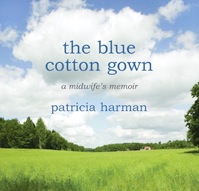The Blue Cotton Gown: A Midwife’s Memoir by Patricia Harman
Oh, I do love this book. Reading it has been like coming across a lovely song—a voice—that I didn’t know existed. A surprise on a late summer day. This summer I took several crates of books to the used bookstore to trade for credit. Much of my credit I’m saving for when students start putting in their requests off my booklist, but while I was there the other week I idled through the shelves and came across this memoir by midwife and nurse practitioner Patricia Harman. I opened to the first line: I have insomnia…and I drink a little. I might as well tell you. In the middle of the night, I drink scotch when I can’t sleep. Actually, I can’t sleep most nights; actually, every night. Even before I stopped delivering babies, I wanted to write about the women. How can you not like a book that begins this way? I suppose I feel a connection because it’s the kind of memoir I had at one time thought I might write, and then never did. It also takes me back to the summer I spent in West Virginia between my third and fourth years of medical school, working in a clinic and getting to know some of the lay midwives in the county. And then in Washington, DC, when I worked as a family physician, I was fortunate to work alongside midwives. I’ve more than once dreamed about them. At different times during my life, when I’ve been in need of help or company, I’ve dreamt about a midwife and it’s always been such a healing dream. So I have a tender spot for midwives. This the reason I bought the book, and was predisposed to like it. And then I took it out to the porch on a summer afternoon, one of my last summer afternoons before returning to school—I’d been awake that morning uncharacteristically at 4 AM, unable to get back to sleep, anxious like a kid before the first day. I took the book out to the porch and I read beneath the fan and drifted into sleep and it was like spending time with the midwives again. Waking with that kind of calm rested feeling like you’ve just been with someone who knows something and this something that they know—you might not even be able to put your finger on it—but it’s just what you need. I’m realizing something—I’m writing everything about my experience of reading the book, and not so much about the book itself. This is not turning into a book review. But sometimes that’s the way it is with a book. It’s the feel of a book that matters. The voice and the images become what matters. A nurse midwife in West Virginia. The women who come to see her and they strip off their clothes and put on that thin blue cotton gown for the exam—and they tell her things. Stories. And then the midwife and her stories become a kind of good company. See also: Cure Cottage The Blue Cotton...
read more

